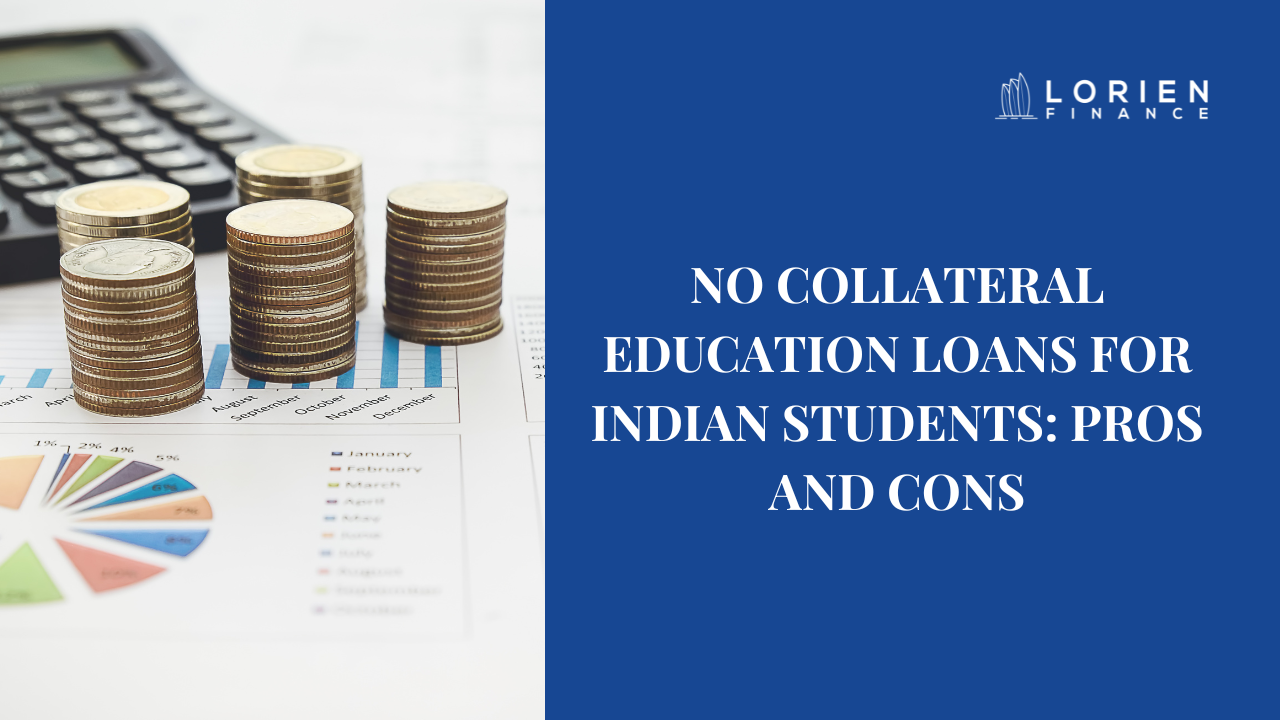No Collateral Education Loans for Indian Students: Pros and Cons

Every year, thousands of Indian students dream of studying abroad—but one major hurdle stops many in their tracks: financing. The biggest barrier? Collateral. Most traditional Indian banks require property or liquid security to issue a study abroad loan. But what if you don’t have that? Are your dreams over? Absolutely not. That’s where no collateral education loans for Indian students come in—offering students a chance to fund their education based on potential, not possessions. And at Lorien Finance, we’ve seen firsthand how these loans are transforming futures. What Are No Collateral Education Loans? A no collateral education loan (also known as an unsecured education loan) doesn’t require students or their families to pledge any property or assets. Almost all lenders—including Indian banks and NBFCs—offer unsecured loans today. However, here’s the catch: when there’s no collateral, interest rates are significantly higher, and the approval process is far more selective. The real game-changer comes when a lender offers no collateral and no cosigner loans—which is still rare. That’s where MPOWER Financing, Prodigy Finance, and Earnest stand out. These global lenders give eligible Indian students access to education funding based purely on academic potential, admission offer, and future income prospects—without requiring family backing or property. The Growing Trend: Why More Students Are Choosing No Collateral Loans Almost all students aspiring to study abroad Google this question multiple times “how to get an education loan without collateral or co-signer”. Many students shared struggles such as: “My family doesn’t own a home. No Indian bank will give me a loan.” “I have an admit from a top US university but can’t get funding because I don’t have property to pledge.” In fact, a recent Google Trends report showed a 34% YoY increase in searches for study abroad loans without collateral from Tier-2 and Tier-3 cities in India. This rise in demand is being met by lenders who believe in the future value of a student’s education. But is this type of loan right for everyone? Let’s break it down. Pros of No Collateral Education Loans The biggest advantage is clear—you don’t need to own a house, land, or have savings in the form of FDs to apply. This makes global education accessible to first-generation learners and students from modest backgrounds. These loans are assessed based on your university admit, academic performance, and future earning potential. This is perfect for high-potential students who may not have strong financial backing but do have bright futures. Many of these loans cover more than just tuition—they also cover living expenses, insurance, travel, and materials. This means you don’t have to scramble for partial funding. Unlike traditional banks that take weeks and multiple physical visits, lenders like MPOWER, Prodigy, and Earnest offer fast, paperless approvals. Some approvals are issued in under a week. All three lenders issue loan sanction letters valid for visa interviews, a major plus when applying to the U.S., Canada, or the UK. Cons of No Collateral Education Loans Because these are unsecured loans, the interest rates are typically 2–4% higher than secured loans. However, some lenders offer interest rate discounts for on-time payments and autopay enrollment. For example, MPOWER has a fixed interest rate of \~12–13% APR, with 0.5–1.5% discount options over time. Lenders often work with pre-approved universities or courses. If your admit isn’t on their list, you may not be eligible. Many no collateral lenders like Prodigy Finance only fund postgraduate (PG) programs, leaving undergraduate students with fewer options (except MPOWER, which funds both UG and PG). Loans from international lenders are disbursed and repaid in USD, EUR, or CAD. If you return to India post-graduation, exchange rate fluctuations can impact your repayment. Some lenders (like MPOWER) charge a 5% origination fee, which is deducted upfront. While this isn’t unusual, students should budget accordingly. Should You Choose a No Collateral Loan? Here’s the bottom line—if you don’t have collateral or a co-signer, a no collateral loan might be your only path forward. Yes, interest rates are higher, but so is the opportunity cost of not attending your dream university. What matters is getting the right fit. That’s where Lorien’s Study Abroad Loan Fest comes in. We bring all top lenders to the table—compare their rates, benefits, and timelines in one place. Your education is one of the best investments you’ll ever make. We know the loan process can feel overwhelming—but we’ve got your back. At Lorien Finance, we help you navigate your options, compare no collateral education loans, and apply with confidence. Whether you’re just starting out or stuck mid-way—we’re here to get you to the finish line. FAQs Is it safe to take a no collateral education loan from international lenders? Yes, if you’re applying through reputable lenders like MPOWER, Prodigy, or Earnest, the process is secure and legally regulated. How do I know if my university is eligible? Check each lender’s website or use Lorien’s free eligibility tool to see if your program is on their approved list. What happens if I return to India after studies? You’ll still repay in the loan currency (e.g., USD), so plan finances accordingly. Many students begin repayment once employed abroad to manage exchange rates better. Which is better: no collateral or with collateral loan? If you have property and want a lower interest rate, go with a secured loan. If not, no collateral loans are a strong alternative based on merit. Can I apply before my visa interview? Absolutely. A loan sanction letter from a lender is accepted as proof of funds during visa interviews.
